#Late Ming Period
Explore tagged Tumblr posts
Photo


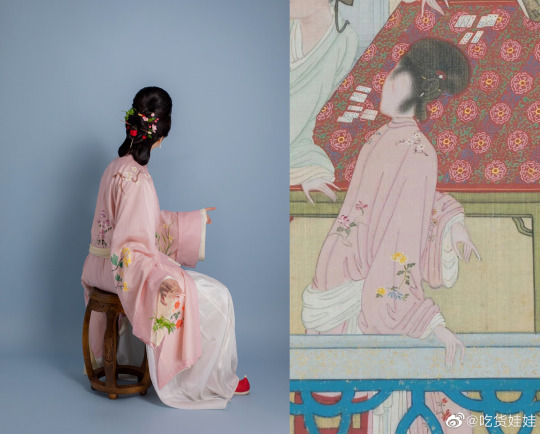
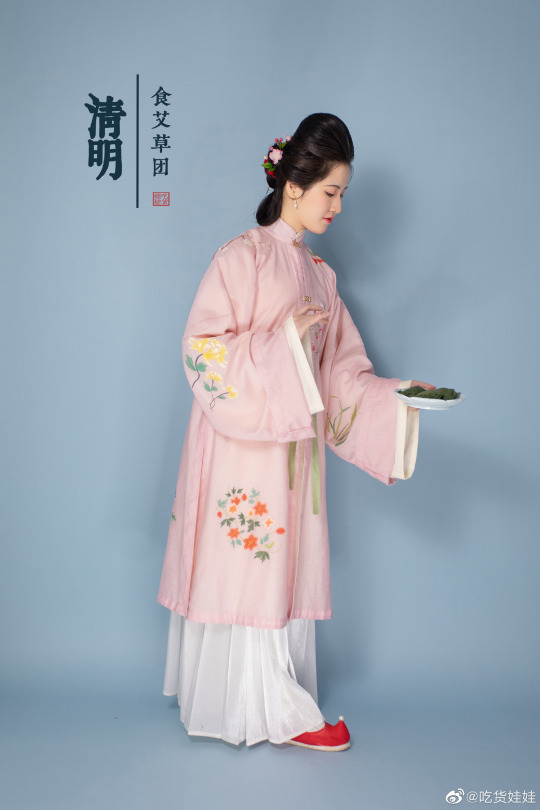



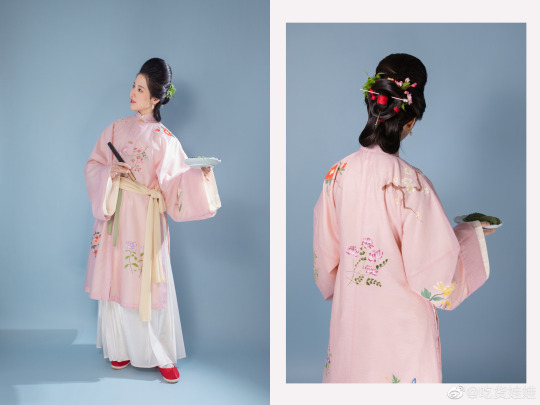
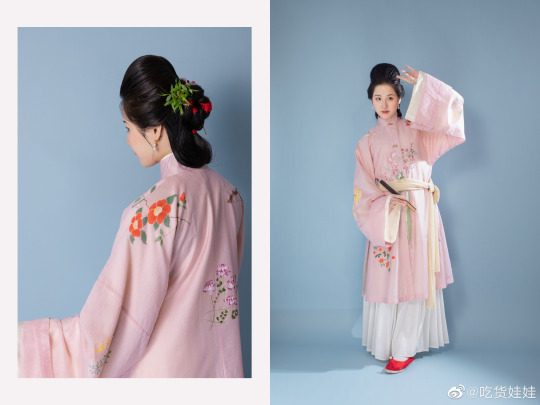
[Hanfu · 漢服]Chinese Early Qing Dynasty Traditional Clothing & Qingming Festival/清明節
————————
Han ethnic Women's attire & Hairstyle ”Peony Head (牡丹头) in the Early Qing Dynasty
Han ethnic Women's attire and hairstyle in the early Qing Dynasty was not like men that force to change by the Qing government. Women's attire and hairstyle were not particularly different from late Ming Dynasty.
————————
【Qingming Festival/清明節】
The Qingming festival or Ching Ming Festival,also known as Tomb-Sweeping Day in English (sometimes also called Chinese Memorial Day, Ancestors' Day, the Clear Brightness Festival, or the Pure Brightness Festival), is a traditional Chinese festival observed by ethnic Chinese in mainland China, Hong Kong, Macau, Taiwan, Malaysia, Singapore, Cambodia, Indonesia, Philippines, Thailand, and Vietnam.
During Qingming, Chinese families visit the tombs of their ancestors to clean the gravesites and make ritual offerings to their ancestors. Offerings would typically include traditional food dishes and the burning of joss sticks and joss paper.The holiday recognizes the traditional reverence of one's ancestors in Chinese culture.
The origins of the Qingming Festival go back more than 2500 years, although the observance has changed significantly. It became a public holiday in mainland China in 2008, where it is associated with the consumption of qingtuan,green dumplings made of glutinous rice and Chinese mugwort or barley grass.
--------
【Qingming Festival Customs: 插柳/戴柳 put willow/wearing willow 】
“清明不插柳,红颜变皓首”:
As the saying goes, it means in Qingming Festival, in the first ten days of March of the lunisolar calendar every year, is the day when traditional customs go to graves to worship ancestors. According to the old custom, when returning from worshiping ancestors during the Qingming Festival, people have to break off willow branches and wear them on head.It is said that if people don’t do this, young people will become old people with white hair.
According to the "Qing Jialu/清嘉录" written by Gu Lu of the Qing Dynasty:
「清明日,滿街叫賣楊柳,人家買之插於門上,農人以插柳日晴雨佔水旱,若雨,主水。」
every Qingming Festival, "willows are sold all over the street, and people buy them and put them on the door.
Q:why wearing willow or put willow on the door?
Jia Sixie(贾思勰)of the Northern Wei Dynasty(386-535) said in "Qi Min Yao Shu/齐民要术": “取柳枝著户上,百鬼不入家。”
“Take the willow and put it on the door/house, and a hundred ghosts will not enter the house”
It is said that a hundred spirits come out on Qingming Festival, and people need to worship their ancestors while carefully keep a certain distance from other spirits and keep them out of house. Willow has become a weapon for people to avoid evil spirits and protect people from them.
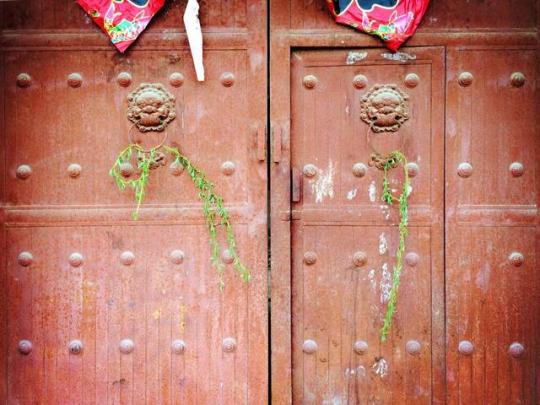
The custom is still widespread in parts of China especially Wudi(吴地) area: area in the south of the Yangtze River
----
In ancient times, there were many interesting Qingming Festival customs. Apart from visit the tombs of their ancestors to clean the gravesites and make ritual offerings to their ancestors, there were also a series of custom sports activities such as spring outing, swinging, Cuju (蹴鞠:is an ancient Chinese ball game) , playing polo etc.
_______
🧚🏻Recreation Work:@吃货娃娃
🔗Weibo:https://weibo.com/1868003212/MAyid6Mtv
_______
#Chinese Hanfu#hanfu#early qing dynasty#Ming Dynasty#Late Ming Period#Qingming Festival/清明節#Chinese Culture#chinese customs#hanfu accessories#chinese traditional clothing#chinese#chinese historical fashion#historical fashion#吃货娃娃#插柳/戴柳
147 notes
·
View notes
Text
i was going to make a shitpost about eunuchs but then i read about the process and the social dynamics of castration in imperial china and that shit was really fucked up. it's almost not worth the price
1 note
·
View note
Text
April 20, Beijing, China, National Museum of China/中国国家博物馆 (Part 4 – Chinese Historical Fashion Exhibition continued):
Alrighty, Ming and Qing dynasty fashion, here we go! Sit tight because this is an extra long post that took me a long time to research
First is this marvel, a replica of the phoenix crown/fengguan/凤冠 of Empress Xiaoduanxian of Ming (明孝端显皇后). The real artifact is in this museum, but it's probably not exhibited much for conservation reasons.

Phoenix crowns are the formal headwear for empresses, which according to etiquette rules set at the beginning of Ming dynasty (1368 - 1644), must have 9 dragons and 4 phoenixes (btw the original Chinese term is fenghuang/凤凰, which is a different mythological creature from the phoenix, but "phoenix" is the commonly used translation now), but this crown has 9 dragons and 9 phoenixes, indicating that etiquette rules have loosened and shifted by late Ming.
The phoenixes on this crown are blue because they were actually made with the iridescent feathers of kingfishers in a process called diancui/点翠. All species of kingfishers are now legally protected animals in China, so when buying hanfu accessories, you may come across "imitation diancui"/仿点翠, these are usually either made with enamel or dyed chicken or goose feathers. Another thing to note is the appearance of the jewels on this crown. Ming-era people liked keeping the jewels in a "natural look", so these jewels had no facets.

Recreations of Ming-era hanfu. Left is the semi-formal outfit of aristocrat women in mid to late Ming dynasty. Right is the casual outfit of late Ming scholars and literati. The woman's cone-shaped hairstyle is called a diji/䯼髻, and the set of hairpins that goes on a diji is called toumian/头面. She's wearing a type of top called an ao/袄 and a skirt aka qun/裙, specifically a mamianqun/马面裙, or "horse face skirt". Note that the bottom hem of an ao is not tucked into the skirt. The man is wearing a square-ish hat called a fangjin/方巾 and should also be wearing a wangjin/网巾 underneath (can be understood as a hairnet). He's wearing a daopao/道袍 and a hechang/鹤氅 on the outside.

Also I did make a mistake while dividing up the pictures for these two posts, some of the following artifacts are from earlier dynasties. Ugh if only I had time to take pictures of all the placards.
A pair of mojie/摩竭 shaped gold earrings from Liao dynasty (916 - 1125). Note that the placard says it's "摩羯形" or "Capricorn-shaped", but this apparently is sort of a misnomer? Sort of, because this representation should be of the makara (मकर; translated as 摩竭 in Chinese), a sea creature from Hindu mythology, but at the same time it is the equivalent of Capricorn in Hindu astrology. However since the name "Capricorn" stuck, it's now commonly referred to as "摩羯". 摩竭 and 摩羯 have the exact same pronunciation though.

A pair of phoenix (fenghuang) shaped gold hairpins from Liao dynasty:

After a lot of pulling my hair out researching, I finally found what time period this gold belt buckle came from. It's from Eastern Han dynasty (25 - 220 AD). The gold filigree and beads form the pattern known as panchiwen/蟠螭纹, where pan/蟠 and chi/螭 are both types of loong dragon in Chinese mythology.

The gold decoration on a xiapei/霞帔 (the V-shaped wide band in the diagram on the right) from Liao dynasty. Xiapei originated in Song dynasty (960 - 1279) as part of the formal attire of consorts, but later developed into a part of the formal attire for women in general. Xiapei also looked different at different time periods in history, but from Song-era to Ming-era, its structure didn't change by much.


Finally back to Ming dynasty. This is a gold cap inlaid with gems and pearls. From the size of this cap and the included hairpins, we can deduce that this cap is meant to encase the bun on the top of the head (the hairpins that go through the cap would hold it in place).

Like the gold cap above, the next few are all from the same tomb of a Ming dynasty noble, and they are all themed similarly--they all depict scenes in a heavenly palace. Of these, the first three that has miniature architecture in gold are parts of the toumian worn on a diji hairstyle. This first one is a pair of yanbin/掩鬓 (lit. "covering temples"), so called because they are worn on the sides, close to the temples.

This next one has some confusion regarding the naming. According to an article by the Chinese Academy of Social Sciences Institute of Archaeology, the top artifact is a fenxin/分心 and the bottom artifact is a tiaoxin/挑心, but according to 撷芳主人 (if you are a hanfu enthusiast you have probably heard of this person or seen their works, they are the one who drew the cute illustrations of Ming-era fashion), the top one may be a manguan/满冠, and the bottom one should be called fenxin/分心. Note that 撷芳主人's conclusion is mostly based on Ming-era records and novels. Regardless of the naming, the top one here should be worn on the base of the diji, and the bottom one should be worn at the front center of the diji.

This one also has some confusion in the naming, the Institute of Archaeology calls it a dingzan/顶簪, while 撷芳主人 calls it a tiaoxin/挑心. Again, regardless of the naming, this one is worn on the very top of the diji, so the hairstick portion goes straight down through the diji. If you look closely, you can even see people and animals in the details.

Left: a pair of gold phoenix (fenghuang) hairpins made in the 22nd year of the Yongle Emperor of Ming. Right: gold filigree bracelets inlaid with gemstones.


Ming-era portrait of a scholar official. Before cameras were introduced in late-Qing dynasty, portrait paintings were the most realistic depictions of what people looked like back then. Such portrait paintings mostly began in Song dynasty and continued through to Qing dynasty.

Illustrations of the different buzi/补子 (also known as "mandarin square") used by different ranks of officials in Ming dynasty. All ranks are organized from highest on the left to lowest on the right, top row is for civil officials, bottom row is for military officials, and bottom right is for nobility. All illustrations here come from the Ming-era illustrated encyclopedia Sancai Tuhui (《三才图会》). For those who are interested, a scan of Sancai Tuhui is available on Internet Archive for free (link goes to first chapter, most chapters are available).

Also from Sancai Tuhui Chapter 62 (all pictures here come from Ch. 62-64), illustrations of the twelve ornaments (called shierzhang/十二章) on a mianfu/冕服, which is the highest level of formal attire for an emperor in Ming dynasty. These twelve ornaments depict things including celestial bodies (note that sun contains the three-footed sun crow, and moon contains the moon rabbit), elements of nature, mythical creatures, and representations of life, and are supposed to represent the values and traits that an emperor should possess:

And wrapping up the section on Ming-era hanfu, here are the headwear of different classes of people in Ming dynasty, from commoners to the literati to important government officials.
Note the net-like hair accessory on the left. This is a wangjin/网巾 during Ming dynasty (illustration from Sancai Tuhui), and is worn by all men regardless of social class. However, wangjin is worn almost like an "undergarment", so it's almost always covered by something else. Which means all those historical cdramas set in Ming dynasty that have their characters wear only a wangjin in public are, in fact, inaccurate.

Some hats of commoners and scholars in Ming dynasty. Note the left one on the second row, that is the same hat worn by the Fox Scholar in the episode Goose Mountain of the animated series Yao Chinese Folktales (《中国奇谭》).

Some of the formal headwear of government officials in Ming dynasty. These are called liangguan/梁冠, lit. "beam crown", where the liang/"beam" refers to the metal arches that go over the top. The more liang there are on the hat, the higher the rank of the official.

And last but not least, Qing dynasty (1616 - 1911) fashion. Left is Qing-era men's outfit for horseback archery and hunting, called xingfu/行服. His hat is composed of two parts, the actual hat called dingdai/顶戴 (here it's specifically the winter version) and the back decoration made of horsehair and feathers that signifies status is called hualing/花翎. Back is the casual outfit of late-Qing Manchu noblewomen, with the characteristic hairstyle called dalachi/大拉翅, a vest called kanjian/坎肩, and a robe beneath called chenyi/衬衣. These are all considered part of qizhuang/旗装, or traditional Manchu clothing. On the right is the late-Qing casual outfit of upper class Han women, with an ao/袄 top and a langanqun/阑干裙 skirt (a type of mamianqun/马面裙), and a headband decorated with pearls called mo'e/抹额. Note that although the exact origin of the modern qipao/旗袍 is disputed, it definitely has elements from at least one of the following: the Manchu chenyi, the Han ao, and the late Qing and early Republic era men's changshan/长衫.

A little historical background on why this particular display is arranged in this way. In early Qing dynasty, the Manchu ruling class enforced the policy of 剃发易服 (lit. "shaving hair and changing clothing") specifically on Han men in order to force conformity to Manchu traditions in terms of hairstyle and clothing, but Han women were not included in this policy. So in early Qing, Han women still wore the same clothing as they did prior in late Ming, but over the time the fashion of Han women absorbed many elements of Manchu fashion. However, this wasn't a one-way influence. By late Qing, many elements of Han fashion were adopted by Manchu fashion as well, so this influence really went both ways. Today, Manchu people is one of the 56 officially recognized ethnicities in China (4th largest ethnicity by population), and the traditional fashion of Manchu people is a part of the diverse culture of modern China.
Below is a real example of a chenyi, chenyi were popular among Qing dynasty imperial consorts as informal dress:

The hairstyle of Manchu women (called qitou/旗头) at different times during Qing dynasty. The one at the far right was what early qitou looked like, while the one on the far left appeared in late-Qing. The two hairstyles on the left frequently appear in period dramas set in Qing dynasty.

A belt called jifudai/吉服带 with pouches and decorations. Jifudai is so named because it's supposed to be worn with the semi-formal jifu/吉服 outfit. This particular jifudai is yellow, a color reserved for the emperor.

Real examples of Qing-era Han women's outfit, with an ao on the left, and a langanqun on the right. Langanqun is a type of mamianqun, but the construction is different from Ming-era mamianqun, in that langanqun is made from numerous rectangular and trapezoidal pieces of fabric sewn together into two larger pieces, whereas Ming-era mamianqun are simply two large pleated pieces of fabric. The way these skirts are decorated are also somewhat different. Visually speaking, Qing-era langanqun have woven and/or embroidered patterns that are arranged vertically, creating a "paneled" look, whereas Ming-era mamianqun have woven and/or embroidered patterns that repeat and extend horizontally as to wrap around the entire skirt.

Aaaaand that's it for this exhibition! Phew. I highly recommend everyone go visit the free virtual exhibition (link here), partly because when I visited the National Museum of China, I was in a huge hurry (I only had one day to see everything), and so the task of taking pictures of the exhibition was split between me and a family member, but I'm not sure they understood how many pictures I wanted....so what's in my posts here are only a very small portion of the actual exhibition. The actual exhibition doesn't just have artifacts and replicas of artifacts, but also have paintings and real articles of clothing from Qing dynasty, which were all amazing to look at.
#2024 china#beijing#china#national museum of china#historical fashion#historical clothing#chinese historical fashion#hanfu#chinese hanfu#manchu fashion#fashion history#chinese history#chinese culture#history#culture
120 notes
·
View notes
Text
"In historical context though-"
This book has potatoes and chilis in supply and demand when these were not traded until the late 15th century... and not used for cuisine and a foods crop cultivator in China well into the 17th and 18th century almost 200 years later. Folding fans that are seen abundantly were not popularized until the 13th century. Taoism was at its largest during the Warring States period of 450 BCE–c. 300 BCE with the epigram of Tao Te Ching. Confucianism became the abundant practice as of 206 BCE to 220 BCE with the authoring of The Analects. It uses fabricated province names for real world Chinese provinces that are relegated to a simple five, when there are of 22 (claimed) and have been the most stable to survive since the Yuan dynasty 1271-1368. Idioms used vary through the centuries and are still a staple of modern day vernacular. The version of futou Jin Guangyao alone wears was a wushamao (乌纱帽), used in the Ming dynasty 1368-1398. Futou was made a part of ministerial and court attire during the reign of Emperor Wu 560 BCE.
The author has said it has no standing Imperial Dynasty it takes place in and has borrowed aesthetics from the Han, Wei-Jin, Song, Tang, Ming and even Qing. All of which had seen several turns of dynasty from Han to Mongol to Han divine rulings. So no, there is no historical context to take in regard when it comes to Madam Yu's overt abuse, to Jiang Cheng's abuse, the clan's classisms and hypocrisy.
It was written in an alternate fantasy of China without this context of real world history and through the lens of modernity of its author. Do not use a history that does not pertain to a novel that is not has not and was never called historical.
128 notes
·
View notes
Note
Carlos and Coco seem to be wearing a ming/qing inpired hanfu pattern? But in a very modern "stylization".
okay imma nerd out about chinese traditional clothing a bit (a lot)
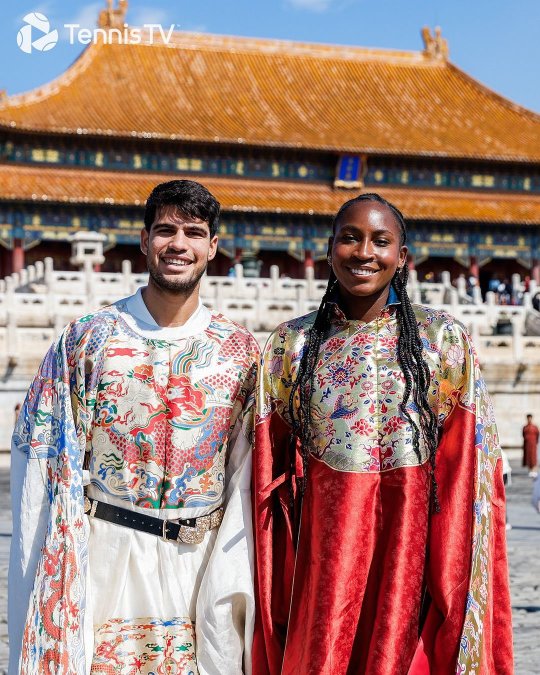


so here they are both wearing mid-late Ming dynasty (roughly mid 15th century - mid 16th century)style traditional Chinese clothing. in this period the economy was good so everyone were wearing pretty cloths with fancy patterns (in a lot of the times peasants were not allowed to wear bright colours and complex patterns), and the clothes and their sleeves were quite long and wide.
Carlos here is wearing a Ming dynasty style round collar robe (明制圆领袍)and I am quite sure that this one is of the mid-late Ming period because there are added pieces of cloth to hem of the robe which started to exist in mid-ming. also they managed to cover up his pants and made the whole thing look a lot more proper lol 😭 and carlos' robe has dragon patterning, which would be extremely bold of him if he wore that in early ming (in that period of time only the emperor or very important members of the government could wear clothes wth dragon patterns) but in mid-late Ming the economy was good everyone were quite happy so people didnt really care anymore. But! looking at the cloth and the pattern design and print the maker of this particular robe probably did not think that much about it because this one is probably from the average try-on-some-tradtional-clothes type of stuff at tourist attractions, and would cost around 300CNY if you want to buy one. The better quality ones can easily go 2000+CNY.
Coco here is wearing a stand-up collar side opening short coat (竖领大襟短袄). yes there is actually a stand-up collar, but this type of collar is usually super tight and shes taller and more muscular than the average asian women so no wonder why she wasnt able to buckle the buttons up😭 this type of collar stated to become popular around mid ming dynasty too. she is also wearing a horse face skirt (马面裙), which is essentially a really large piece of cloth (its actually two pieces sewed together but anyways) with a lot of pleats but three of them are super wide, and you wear it by wrapping it around your waist with the wide pleats at the front and the back of your body. its the standard lower body clothing for women through out the Ming dynasty, and were also quite popular in the Qing dynasty too. on a side note this thing is actually super comfy and easy to move around in, i some times wear mine on a normal day with a shirt or a sweater or any top and they go together quite well
to explain the two pieces sewed together part ⬇️

and im getting a bit unnecessarily emo over this because when rafa and jcf and moya did that very similar photo shoot in 2005 they were wearing very historically incorrect costumes because knowledge about traditional clothings of the Han ethnic group (ie the majority of chinese people) was largely lost because of several historical events and also people genuinely didnt care. from around 2010 people started to recover knowledge about our traditional clothing again and it started with a very niche group of people (including me) making, buying and wearing very poorly made, quite ugly and historically incorrect clothes lol😭😭😭 so its quite nice to see even though they just pulled out several pieces form the average try-on-some-tradtional-clothes at tourist sites type of collections, these pieces are more or less based on actual historical clothing (tbh the patternings are still kind of sus but its still a huge step forward 😌)
67 notes
·
View notes
Text

Week 8 - My Stand-In News from YYDS Entertainment
The police received complaints from villagers. Normally in a quiet alley there are never dogs. Well, many dogs are barking at the same time at yesterday late nightt. They tolerated for a while and finally couldn't stand it. They went out to see and found a young man age around mid-20 leading three dogs and ordering them to bark periodically. Creating distress for the people in that area. In the near distance, another male was found standing on the fence of the house. crying like he was in a drama. It is believed that it was a filming crew that filmed overtime without permission. The officer ordered a fine of 500 baht for the dog leash. The accused works as a secretary. The police kindly reminds them not to let it happen again.
Warning from official! Beware of high-interest informal loan gangs using force to collect debt illegally. Many people were damaged and injured. At this time there are no clues to the culprit. If seen, you can report it.
TONG-TINKARN IS APPRECIATIVE THAT THE PREMIERE OF 9 SWORDS THE MOVIE RECEIVED RESPONSES FROM FANCLUBS AND MEDIA. Tong-Tinkarn revealed that during filming, he worked hard in rehearsals. He played all the action sequences himself by not using a single stand-in. He got slightly injured during filming but worth it for this work. Thank you to the audience for the good response. He is confident that the second part will definitely receive higher income than the first part. And he is ready to become a billionaire movie star
Mike-Methiyut Akrahyothar, the new generation heirs of the Akrahyothar Group. He is glad that sales of light filter film for building continue to grow in the Thai market. There is also a large amount of exports to foreign markets. This helped him to win the election results from the most recent board meeting and sits on the podium as the new president of the Akaryothar Group. In an interview, he said that the company often produces products to solve problems in the daily life of consumers. Revealing company plans for the second half of the year, he is ready to enter the digital key market. The newest product can be used through the fingerprint and face scanning system. It solves problem for some users who like to forget their condo keycards. This digital key provides maximum security. The product is still under development.
So Ming had Secretary Jim make the dogs bark at him so he can dramatically cry and beg Joe to let him in. Meanwhile, his brother Mike is making yet another investment venture to prevent his brother from playing Romeo 😭😭😭😭😭😭😭

#my stand in the series#my stand in#yyds entertainment#they're unserious as hell and i loveeeee these tidbits#they're the best#my stand in you will always be that bl of 2024 for me#i love how interactive yyds is making the promo cycle of my stand in
102 notes
·
View notes
Text
- God Shattering Star


【 content; morax | rex lapis x reader , slow burn , mutual pining , multi-chapter , archon war period , afab!reader 】
【 note sorry this is also late i had to redo this chapter like 3 times cause i wasn't happy with it, i should stop re-reading a song of ice and fire while writing this 'cause i keep comparing my dialogue skills with fucking george rr martin and feel sad 。゚(*´□`)゚。 | read on ao3 】
【 word count; 6.016 | previous chapter - next chapter | masterlist 】

- Chapter 8 - Consumption
You barely recognise life anymore—or anything for that matter. You feel sick, sticky and heavy, as if your body is full of liquids in every crevice. The world around you feels lighter than you yourself do, like you’re sinking below it and perpetually struggling to reach upwards to grasp at the people staring down at you from around the cot.
Ming Hui sets her hand on your stomach, and a pain so consuming you thrash and scream overrides any thought or consciousness. Hands hold you down to prevent you from hurting yourself or anyone else as the smaller girl tears (at least that’s what it feels like to you) blackened liquids and blood from the lacerations on your belly.
You throw up every day, most of the time several times a day, nights are filled with shivers and huddling under blankets when you try to close your eyes to sleep—and wake in the middle of the night, soaked with sweat and fever.
One night, you had a terrible dream—you’ve been having many bad dreams, terrible, suffocating dreams. Nightmares. You woke up to two pairs of hands shaking your shoulders, clapping your cheeks lightly in hopes of waking you before you hurt yourself.
Another night, you couldn’t sleep, you kept seeing dark snakes slither between beds—you told yourself that they aren’t real, there are no snakes so high in the mountain of Liyue… they are far more common between the mountains, in thick forests with plenty of opportunities for food for their size.
They never approach your bed, one circles around it before disappearing behind a shelf of ointments. Later the same morning, exhausted and dozing from a sleepless night, you thought you saw a white snake under the bandage around your left arm looking at you, you reached out to pet it, but it slid back inside. Into your bandages. Into your skin.
The week drags on for what feels like several of them. Every morning, Ming Hui would perform a cleanse and try to purify parts of your body to keep the miasma from spreading into it, but you weren’t sure how much it was helping, at least, you didn’t start feeling better until a week and a half after the seven days of cleansing.
With a groan, you prop yourself up and get into a sitting position, fumbling to grab one of the seven or so books on the table next to the cot, you let it fall open onto your lap. Staring at the ceiling is impossibly boring, and you hope your body is giving you some energy to use your brain at least a little. The book doesn’t have a name on the cover, nor does it look like a printed book—it’s full of handwriting and for a moment you thought Guizhong might have accidentally lent you a diary… but as you squint and read further, you see that it’s something of a logbook.
Documentation of a crew’s trip on the sea, the management of resources and the direction of the winds… it’s a surprisingly soothing read, you craft the ship in your mind and imagine the soothing brush of waves against the wood, sun beating down and warming the skin.
You open your eyes again as a healer touches your shoulder and asks to see your left arm again, you didn’t even realise you fell asleep. The prickly sensation of their fingers prodding at your arm is strange, like it’s felt through a few layers of clothing… you can feel it, but just kind of. You feel like you used to be able to tell what texture was touching you—a finger or a glove, the grass or floor. But now it all feels like the same kind of poking. You feel trembling, like the bed is trying to shake you off, but you're not cold.
You feel a fragment of dread every time Ming Hui comes up to your bed, but thankfully the last few times, she’s just been bringing you things. Doughy snacks from the capital, some sesame balls from the kitchens, papers and ink to draw on, anything. Unfortunately none of the foods or snacks stick in your belly for long… but it’s nice to taste them, if only a small nibble with the front of your teeth and a poke of your tongue.
It has been a long morning, you had woken up early due to your back starting to hurt because you’ve been laying down for so long—you really wish you could start to walk around, but even just sitting up feels like you’re leaving half your organs behind on your mattress… you look up as you hear footsteps approach and see a familiar face, though not one you expected.
Cloud Retainer—rather roughly—takes your arm and lifts it up vertically, you make a strange startled, as well as surprised sound and try to tug it back, but she holds it firmly. Ground Mender follows behind and sighs. “Be gentle,” she scolds.
“Hmph, a sound of pain merely shows there’s still feeling in the limb,” she moves it horizontally and squeezes the sides of your elbow, you have no idea what she’s doing. “Squeeze into a fist for me.”
You do as she asks, curling your fingers as much as you can—it’s not a very good squeeze, if any, but you manage to curl them into a fist with trembling fingers, your fist twitches from the effort. “Like this?”
“Hm, good enough,” she nods and begins to undo the bandage. You look at Ground Mender, but she doesn’t seem to stop the other adeptus, so surely it’s okay… the bandages have been changed many times, but you’ve always been either been half-asleep or too out of it to pay attention to it. The white cloth falls away from your skin and reveals a rather uncomfortable sight—your arm looks like it’s been through the ringer. The skin is uneven and looks more like crumpled parchment stretched over bone than the arm you’re more familiar with, the deep wounds were beginning to close but you could still clearly see the raised edges where it separated, having been knit together twice.
It’s a mangled, uncomfortable thing, your fingers twitch and a dull tug pulls at your senses where you think your joints should be—as if the entire arm was misaligned, off-kilter.
Cloud Retainer turns your arm wrist up and then wrist down, looks at it with a scrutinising eye behind those red-rimmed glasses. You wonder if adepti need glasses or if it’s just fashion.
“What are you searching for?” you ask, your arm is tired, being raised like that for so long. You want to let it lay down and rest.
The adeptus pokes your palm with a sharp nail and your fingers twitch again, your eyebrows furrow in mild annoyance… you can only tolerate being prodded at without explanation for so long. Finally, she graces you with an answer. “The miasma is concentrated heavily in your arm, most of what was in your stomach has been pulled out… but there is little to do with this part here.”
You look down at your arm… it doesn’t look as rotted as you recall others’ bodies would become after as long as it has stayed in your arm. A bit discoloured, maybe… just, different. “Little to do? Extraction has never failed… can’t we just dig in and drag it out…?” you don’t have the energy or capacity to recount a lengthy process, but cleansing has never failed you—you have yet to find an object or person who was too far gone.
And surely, you are not…?
Cloud Retainer wraps your arm again carefully, you see the golden eyes of a snake staring at you from between the bandages.
“Then… what do we do?” you ask as if there was something for you to do. You can barely hold your arm at chest-height for too long.
Cloud Retainer holds her hand out to Ground Mender, who hands her the familiar wooden board someone is always holding when standing by your bed. “Observe for now, the miasma is contained below your elbow—” you look at the ink on your arm, locked. “—and it doesn't seem to be rotting the skin, it’s stagnant.”
You were better for a while, and got worse again.
You could imagine the ship, high tides and low, rocking among the waving ocean—a peek of sunlight. Two suns, warmth and stability. A calm sea surrounded by raging waters.
The perpetual taste of bile stings the back of your throat, it’s a wonder if you aren’t in danger of malnourishment—you’re unsure you’ve kept down a meal in three weeks. Your head swims and you get nauseous if you lie down, you’re nauseous if you sit up. The world spins when you try to stand, even with attendants insisting you move your legs and body to prevent clotting from forming in your feet. You are practically hauled onto a cart of some sort that holds only your upper body, when strength slips between your fingers and you slide off—only just barely caught by the attendants and brought back to bed, they decide to just assign someone to apply pressure to your feet instead to promote blood flow.
It’s strange… it’s all treatment and techniques you’ve familiarised yourself with over the last months you’ve been working for the capital. But it feels so foreign to be on the receiving end.
Like a rocking ship, you managed to down some foods one morning—and kept them down over lunch time, for the first time in… how long has it been? You feed some of the congee to a smaller snake by your bedside.
Everyone around you seemed very excited, but you didn’t have the energy to return it—you know in your heart and gut that it could change at any moment… your day moves slowly as you flip the page of a rather difficult book Cloud Retainer gave to you, it’s only about half writing and the rest is just numbers. Your eyes rise when you see Morax approaching your bed, and you straighten instinctively—he has something in his hand, a bamboo food basket with a long handle. “Good afternoon,” he greets evenly and takes a foldable table that’s used to prop on the bed to allow patients to eat there. He sets the basket on the table over your lap—over your book—and steps away again… Morax has been very quiet recently, and you’re unsure why. You would never say you know him well, you are just barely on greeting or chatting terms, but you still feel a sense that something weighs on his mind.
He returns again with a spoon. “Zhou’s son recently made travels to the west, and on my walk through the streets, the old man demanded I try some cuisine his son had studied there. This is supposed to be easily digestible,” Morax takes your right hand, despite it being very much healthy and mobile. His slender fingers slide below your wrist and lift your hand where he lays the spoon against your upturned palm, your fingers instinctively curl around the cutlery despite the fact that your eyes aren’t watching it. His expression is firm, stiff and stony.
“It’s not dinner time yet,” you’re not sure why you said it, perhaps the silence was uncomfortable, or you want his gaze to leave your torso and rise to meet yours.
He blinks, there are so many things on his mind that it gets pulled away even in the respite he’s taking in bringing you food. “Yes, my apologies. Master Zhou was rather insistent that I stop by and taste his son’s food no matter the time of day, he said finding me during meal hours is too complicated,” Morax lets go of your arm and his hand goes to the basket, he takes the top off and the dish out.
While the congee you ate this morning was nice and light on your stomach—this dish was a pale yellow as opposed to the white of the congee. It smelled warm and comforting but mild, like a stone left under the midday sun, a hot spring on a cold winter’s day in the mountains where the flakes melt against your cheeks, but your body and shoulders are enveloped in a warmed watery blanket.
You stop staring at the dish and stick your spoon into it, it’s soft and moist, the rice separate easily as you scoop a small bite past your lips, careful not to have too much at a time—your stomach has traumatised you over the week by acting up over the smallest thing.
“Ground Mender and Cloud Retainer surmised that though initially we thought enough of the miasma had been cleared from around your organs, your body is still too weak to push out the rest by itself,” Morax finds a stool to sit on next to your bed, not wanting to intrude on the mattress itself. In your convinced state, the bed is your only privacy space that only feels more confined when the curtains are closed around it.
The bite of food fills your mouth—and though your taste buds are extra sensitive now with not eating a lot of foods for so long… licking a sesame ball doesn’t count for much, it tastes very much like the warm embrace the smell and temperature brings. The rice is soft and nearly dissolves on your tongue, the creamy texture of the bite spreading in your mouth and down your throat—it’s five times more warming and powerful than a sip of warm water to smooth out your scrunchy stomach. It gets to work and you instantly feel a sense of ease.
Morax watches you as you lick your lips, dipping the spoon again. “What is it? It’s very nice,” you ask as you take another—now a fuller spoon—of the surprising dish.
“Khichdi,” Morax says the word carefully, as if he were trying to mimic a pronunciation. “After master Zhou’s son returned, a lot of the dishes he learned to make have become very popular in the neighbourhood.”
You hum, you can see why—the flavour is very unique, even if it’s not very strong, it’s likely made with ingredients not found in the Guili Assembly. “Some vegetables could add to it,” you muse to yourself, but quickly try and correct yourself. “I-I mean, it’s very good like this, thank you—”
Morax, however, seemed sheepish for a moment. “Ah… there are vegetables in it… but master Zhou asked for your preference and I couldn’t answer, I deemed it safer to ask them to chop a chosen few of them into… miniscule pieces, in case chewing would be discomforting, or you didn’t like the taste.”
You look down at the bowl, sure enough, there are specs of green and red—how small can you even chop a vegetable?! This looks like a crumb of salt, you think as you squint at a tiny flake of red on your spoon between two grains of rice… your taste buds are in shambles, even just the flavours of this was making it difficult to tell the ingredients, though there are some you have never tasted before. “Ah, thank you for your consideration,” you say before setting another—now spoonful—in your mouth. You almost wish you had bread now, when even two days ago you couldn’t even think about food without your stomach curling up.
Another silence lingers, but it’s not uncomfortable—not waiting or hesitant. You slowly eat while Morax sits, he looks around the calm ward, it’s usually only used in dire circumstances—when the usual infirmary tucked on the first floor on his side between the palaces is full, you’re the only patient being tended to now. “Perhaps you will soon be ready to go above ground,” Morax says absently, not turning his head to you yet.
“Hm? Someone could surely carry me there now, I can try walking again,” you say after a swallow, realising you were eating a bit too fast, you slowed down; your grandmother wouldn’t have you consuming a meal made in kindness at breakneck speed without appreciating the flavour and effort.
“Though I’m glad you feel confident, I would rather avoid you hurting yourself,” Morax shakes his head slowly. “We will see what Ground Mender says in the morning, if you keep this down.”
You better, you tell yourself.
Morax stuck around until you finished, and he helped put away the wooden board as well as placed the bowl back into the basket which had been set aside. You expected him to leave, but he walks around the bed to the side of your injured arm and extends his own right hand. “May I?”
Raising your arm slowly, it stutters and jerks slightly, as if you were fighting against your own muscles for them to listen to your commands.Morax takes your arm kindly, treats it with a gentle touch you would expect from a seasoned healer… a soft glow emits from his hands and you feel their warmth seep into your skin, for a moment it is comforting, a taste of the khichdi from his hands to your skin.
But suddenly, it’s too hot—it burns.
You yank your arm back instinctively, as if you had laid it on a raging fire and not realised until the flames licked your skin. “Ah—” your right hand fingers dig into the bandage of your left arm, trying to squeeze away the pain, to inflict it differently and drain it out.
Morax tenses at the sudden reaction, his eyes flashing with a strange emotion you didn’t see long enough to discern. “What is it?” he asks with urgency, but he doesn’t touch you again. Not if it was his touch that was the cause of your startling. “Did I hurt you?”
“N-No,” you say quickly, but you’re not sure—it only happened because his fingers rested on your arm, but they were gentle, like leaves brushing against cobblestone in a drifting breeze. “What were you doing?”
You don’t mean for your question to sound accusing, you hope Morax doesn’t take it as such. He looks from your eyes down to your clutched arm, eyebrows pinched in thought. “Does it still hurt?”
“A little…” you mumble. Your arm tingles and your fingers tremble slightly, it has felt strangely cold—as opposed to the warmth that always emanated from corrupt skin, the miasma displaying symptoms of infections, because one corrupted is being infected.
“I was merely examining your energies, but as soon as I touched them…” he looked at his own hand. Your body had rejected his energies before—but they had not simply evaporated now, he was pushed back.
He does not like it.
You rub at your arm gently, nails scratching at the bandage now that you had the excuse. The bandage is wrapped so densely, your skin is moist and itchy. “Don’t scratch it,” Morax scolds as you do, and with a defeated sigh you look up at him again and tense.
There is an unmoving silence before you quickly look away again, but Morax saw the surprise and—fear? Concern?—on your face before you turned back to your arm. He says your name firmly, firmer than you’re sure you’ve heard before. “What is wrong?”
“Nothing,” you say quickly. There was a snake around his shoulders. Writhing and wrapping around his throat.
They’re not real. You must just be malnourished, sick. Hallucinating.
Morax doesn’t react when the snake squeezes his neck.
It’s not real.

You pant, heart racing and pounding against your chest—you feel it so vividly you’re sure you could lay your fingers over your chest and pinch it when it presses between your ribs. You feel dizzy, and disoriented, eyes looking down to your left arm, it’s there—all fingers attached as usual.
Just seconds ago it had been red, open, you could reach out and touch the bone, you could wrap your fingers around it while your skin and muscles slipped off your arm and landed with a wet squelching sound on the floor.
You’ve been having nightmares again.
It doesn’t have any comprehensive or predictable patterns, one night your head is in the maws of a beast, another you’re drowning under a tidal wave of iron-tasting water, unable to breathe or see as it stings your eyes and burns your lungs. You squeeze your eyes shut, running your right hand over your face tightly, squishing your nose slightly with your palm.
It’s exhausting. The day is tiring enough already, and you find no solace in sleep. You don’t even have the luxury of turning from one side or the other, any position other than flat on your back feels like your intestines are going to spill out through your belly button.
You glance at the breakfast laid out for you, sitting on the bedside table as it cools. Congee and some bread… but you don’t feel hungry. Not for what feels like the hundredth bowl of congee, you haven’t returned your meals in a few days, but yet Ground Mender denied you when you asked if you could be brought above ground.
“We don’t have much space in the palace infirmary.”
“Did something happen?” you had asked, you hadn’t heard of anything, but you haven’t heard much of the outside world in a while.
Ground Mender changed the subject without telling you, and you were starting to feel that you were being kept alone in this massive hall for… what? You’re getting better, slowly, you managed to walk around your bed with some support, but you would never make it up the endless staircase leading to the sun-touched hallways.
It’s been a month and a half, according to an attendant that brought your breakfast. Your muscles have atrophied terribly and even just standing so someone can help you bathe is exhausting.
A hand touches your breakfast tray and you look up to see Moon Carver. It feels like every person you’ve met in the last months has been coming around to check on you… it’s strange. You’ve never stayed in one place for long enough for anyone to notice absent days of sickness, to inquire why you close your home off for cleansing for a week.
You had returned to a small village that specialised in silk weaving and no one had remembered your face, despite the fact you had discovered the foul energies poisoning a part of the nearby forest, which caused a devastating number of lost silkworms over the span of three years.
You had seen your reflection recently and didn’t recognise yourself either.
“Time to stretch your legs, come on,” the adeptus tilts his head for you to get up. “The more you skimp out, the longer it will take to build those muscles up again.”
If you don’t move, he’ll continue to pester you… you move the blanket off your lap and Moon Carver takes under your right elbow to help you stand. You’re steadier on your feet than you were before, but you always feel like your legs’ sense of balance is different from your mind’s.
“Starting to think you ask for babysitting duty,” you mumble, a poor attempt at humour as you take careful steps. You feel exhausted, but not like you would after running—there’s no burn, there’s no ache or cramp. You just feel like you’re going to slink down onto the floor like a dropped paper, swaying back and forth before gliding under a cabinet.
Moon Carver huffs, his grip is strong. “It’s not easy to say no to this one’s Lord.”
“Would you if it were?” you wonder why Morax would ask Moon Carver to check on you, surely he has more important things to do.
He doesn’t answer, changing the subject. You’ve started to notice that when an adeptus doesn’t want to tell you something, they will just become quiet or dodge your question. “Let us go towards the stairs and back.”
You frown. “All the way? It’s far…”
It’s barely thirty steps, sixty in total there and back. You’ve walked this distance without a thought several times, so many you can’t begin to imagine how often. Light on your feet, walking briskly with tools, trays or heavy baskets you are sure you couldn’t try to lift up now.
It seems so far, yet you know it’s not. You just have to put one foot in front of the other, not think, not look at the distance, look at your feet, the floor.
You’ve had different nightmares.
Strange, different.
Sinking below the claustrophobic, choking earth. Deeper into the iron water. Sinking. Watching the surface of the world like a reflection of sunlight from above the sea, blinding.
They’re vivid, but not scary.
Just strange. Different.
Not nightmares.
You wake and feel the warmth of the sun on your cheeks, it filters through oiled paper and you shift to your side. You don’t feel pain laying on your side anymore, but it’s not comfortable either… but you want to sleep, and the sun—though filtered—is in your eyes. You prefer to lay on your right side when you rarely roll, it’s easier if you have to sit up.
“Hmm, I would have thought you would be happy to see the sun?” Guizhong sets her hands on her hips, standing next to your bed suddenly—you didn’t hear her approach, but her preference to forgo shoes makes her footsteps very quiet.
You are happy to see it, Moon Carver helped Ground Mender carry you up the stairs last night. There’s less quiet in the palace infirmary, more patients coming and going and attendants rushing about… but as you don’t feel as sick as you did even just a week ago, it’s not as overwhelming to hear people wandering about, if anything, it’s comforting.
“I am,” you mumble, giving up on your prolonged rest to turn back on your back. “It’s warm.”
“It won’t be for long, summer is coming to an end soon,” Guizhong approaches your bed and makes room for herself on the side of it next to you. “You should try and enjoy the warmth while it’s still here, do you want to go outside?”
You do, you want to feel the warmth of the sun on your skin, to breathe in the fresh mountain air and feel the breeze ruffle your clothes.
But you don’t trust yourself to make it alone, even if you were to just stand by the walkway and hold onto the railing. “Will you help me?”
“Of course,” Guizhong moves off the bed and straightens. “Let’s greet the fishes in the gardens.”
You want to squat down and let the carps nibble on your finger, but you worry you might not be able to get back up easily, or you might pull on something. Instead, you merely stare longingly while Guizhong kneels down and feeds them from her hand.
There’s not much wind today, barely the breeze you longed for—but even just the soft brush of air is more than you’ve had for weeks. You squint up towards the sky, a few clouds lazily drifting across the vast expanse as the sun hangs high above your heads.
You hear the waters of the pond and small stream that cuts through the back gardens, a usually peaceful ambiance that makes you slightly uneasy now. You can’t imagine yourself stepping into a river anytime soon… you know that rationally, there is no danger in the small waters of the gardens, but the thought of touching the waters makes your skin crawl.
Footsteps approach the two of you and Cloud Retainer stops next to you—she has a floating bird crafted from bamboo and paper next to her, you hope it doesn’t shoot darts at the fish—with a flourish of her hair. “Your breakfast is waiting for you.”
Ah. “I’m not hungry,” you turn your gaze away from the eccentric inventor, looking down to the Lord of Dust that pets every fish that comes to eat from her hand.
“You said the same thing last night,” she folds her arms over her chest. “You need energy.”
She’s right, of course. “... okay, I’ll try.”

You sit on the side of the road, a weary log under you and soft grass beneath your feet, the sun slowly sinks below the treeline as you stretch your legs and raise your gaze to the pink sky, your surroundings are peaceful and silent—a captured moment in time where you get to be alone with yourself.
Long, high trees line the road behind you and shield you from the rest of the world, the view before you is a comfort and home. Rolling hills, distant farms and fields of flowers spread over the land, coloured orange and pink with the reflective sky.
A child runs past you, they trip on a rock and tumble to the floor—but no sounds of pain leave them, giggles and snickers as an older sibling runs past them, grabbing their shirt and hauling them up on their feet as they continue their sprint.
You don’t recognise them, but they feel familiar.
You feel no wind nor the heat of the sinking sun, the sky is clear of clouds and birds, there is nothing but the wide scroll of the heavens furling across the air, opening up to reflect their blessings of fertile lands and fresh produce. You stretch your arms above your head and stand up, patting your clothes down to rid of any grass or dirt before continuing on your way.
You see him in the distance, and your pace increases. A flow of white robes and long brown hair, he turns off the gravel road and walks towards the thick treeline. Where is he going? You only see his back, the golden lines glowing in the darkening surroundings—as if beckoning you to follow, a guiding light.
But before you can leave the road and follow him into the forest, a hand grabs your elbow and stops you.
You hear your name and blink—there’s no trees in front of you, there is a deep crater that is centred with a pool of water. Dry dirt crumbs fall down from below your foot and roll to the body of water, creating ripples in the still waters.
Suddenly, you feel as if all the weight of the world is bearing down on your body, you’re cold, your feet hurt—you’re not wearing shoes. You stand at the edge of a crater, one step from tumbling down, and in the battered state you’re already in, it wouldn’t be a good tumble. You look back and see Morax staring at you, his hair is tousled and eyes strangely wide—you have never seen his face make such a vivid expression, one of surprise and concern. He tugs you backwards and you fall into him, your legs give out and tremble with strain. There’s a dull, agitating throb in your arm and stomach, a pulsing throb in tune with your heartbeat, in tune with the sway of the grass around you. Back-forth. Back-forth—
You hear your name again, his arms hold you up and prevent you from sinking down to the ground. “Can you hear me?”
You can, but you find it difficult to voice your confirmations. You’re cold, it’s nighttime—how is it night already? The stars dot the sky with bright flickers and you try to stand, but your feet feel like heavy weights, a thrumming prick of needles rushes through them when you try to put pressure on them.
Why does it feel like he is always seeing you at your worst?
Sick. Injured. Hurting.
You would rather fall into the crater, he must think you a burden on—
“You’re trembling,” his voice is louder than the brushing wind, louder in your ear than the sway of branches and rustling of leaves. “How have you found yourself here? In the darkness of night, alone and so far from the city?”
He sounds different, urgent and more pointed—as if a front has been reached through, a hand through fog holding your arms as he steadies you against him. Morax’s body is warm. “You… it was you, I was following you,”you finally manage. But when did you start chasing him? You don’t remember starting a journey.
“Me?” he hesitates for only a beat of your erratic heart. “Are you certain?” Morax reins in his urgent tone, carefully choosing his words. “Word was sent to me that you had disappeared from your bed, it has been two days—do you know where you are?”
“No,” it’s an easy question to answer, despite it being so difficult to think of what had just happened mere hours ago, days ago—a week ago. Your tense of time is ruffled, what had been the last thing you had been doing? Were you asleep before or after finishing the book Guizhong had left you?
“The energies in your arm have spread again,” he moves—tugging your rather limp body along with him as he kneels on the soft ground. You feel the tickle of grass on your calves and realise you’re still wearing the short pants and shirt you were put in and made to use by the medical ward. Morax tilts you towards him as he unfurls the bandage on your arm, your side and right arm rest against his chest and torso, your head falling rather lamely against his shoulder—it’s a strangely intimate position that neither of you consider given the circumstance, it doesn’t feel intimate, it only serves the purpose of not having you fall over while his hands are occupied.
The ink that had been sealing the miasma below your elbow was smudged—this type of ink doesn’t smudge for this specific reason. Blackened veins travel up your arm, so stark against your skin that they might as well be drawn on. They rise up your bicep and fade just below your neck. Morax’s eyes are focused and firm as he turns your throbbing arm palm up to examine it further. “The seal has been torn,” his fingers ghost over the blackened veins on your arm, you’ve only felt his gloved hands before, you wonder if his fingers are softer than the texture of his clothes. “You said you were following me.”
You were… or, you thought so. “It looked like you,” you say it more so to yourself than him.
“Did you see its face?” he asks as he wraps your arm again, your skin is ice cold to the touch—the weather has cooled as summer is coming to an end, and with the Guili Assembly’s elevated land, it gets colder faster.
“No,” you mumble, shoulders raised as a cool breeze brushes past your neck, raising shivers on your skin.
Morax doesn’t ask further questions, but it doesn’t leave his mind either. He believes what you say, what you saw… real or not, it only serves to drive his concern for your well-being, physical and mental.
His hand raises, and you feel something touch your head. You squint your eyes open—you didn’t even realise you had closed them—and tilt your head to look at his face. Morax’s face is so close you can feel the warm brush of his breath on your cold chin, it blooms over the bottom half of your face. “What are you doing…?”
His fingers halt and lift from your head, Morax blinks down at you. “I… heard it is a sign of comfort.”
He was patting your head, trying to comfort you—it was… rather cute, that he tried even while struggling to grasp whether it would be appreciated or not. “Oh… thank you, it’s okay,” your torso doesn’t feel as cold anymore. Morax seems to take your waiting eyes as permission, and his palm rests on your head again, carefully. He doesn’t stroke or scratch like one would do with a pet or animal, his palm and fingers lift slightly and touch back down a few times.
You never thought you would be petted like this by a god, had you told yourself a few months ago, you would have found it funny—silly maybe. But… now that his warm hand touches your head gently, you find that it is comforting.

#⭒ - gss#genshin impact x reader#morax x reader#rex lapis x reader#zhongli x reader#genshin x reader#morax x you#rex lapis x you#zhongli x you#multi-chapter#fics#my writing#afab reader#genshin impact
44 notes
·
View notes
Text
For anyone who's enjoyed the recent posts about Tarot-as-a-game, in a surprising bit of kismet, our newest episode covers that topic as well as other matters of playing-card history.
We all like TTRPGs, but what about integrating other games into your tabletop play? This week, we're exploring the history of playing cards, their many variations and occult practices, and how you can utilize their unique history for your worldbuilding and campaigns.
Images and list of suits here.
Join our discord community! Check out our Tumblr for even more! Support us on patreon!
Get your copy of Marginal Worlds, a deck of 50 magic items pulled directly from medieval manuscripts, built for any TTRPG system here!
Socials: Tumblr Website Threads Instagram Facebook
Citations & References:
Berry, John. “Chinese Money-Suited Cards.” The Playing-Card, vol. 31, no. 5, 2003, pp. 230-6.
Caldwell, Ross Sinclair. “The Devil and the Two of Hearts.” The Playing-Card, vol. 37, no. 2, 2008, pp. 126-41.
Caldwell, Ross Sinclair. “The Proto-Historiography of Playing Cards: Early Hypotheses and Beliefs about the Origins of Cards and Card Games in Europe.” The Playing-Card, vol. 38, no. 2, 2009, pp. 92-118.
Chatto, William Andrew. Facts and Speculations on the Origin and History of Playing Cards. London, 1848.
Culin, Stewart. Korean Games; with Notes on the Corresponding Games of China and Japan. Philadelphia, 1895.
Decker, Ronald, Thierry Depaulis, & Michael Dummett. A Wicked Pack of Cards: the Origins of the Occult Tarot. St. Martin’s Press, 1996.
Dummett, Michael. The Game of Tarot: from Ferrara to Salt Lake City. Duckworth, 1980.
Dummett, Michael. “The History of Card Games.” European Review, vol. 1, no. 2, 1993, pp. 125-35.
Hargrave, Catherine Perry. A History of Playing Cards and a Bibliography of Cards and Gaming. Houghton Mifflin, 1980.
Janssen, Han. “The 14th Century and the Introduction of Playing Cards into Europe.” The Playing-Card, vol. 34, no. 3, 2006, pp. 173-80.
Lo, Andrew. “China’s Passion for Pai: Playing Cards, Dominoes, and Mahjong.” Asian Games: the Art of Contest, edited by Irving L. Finkel et al., Asia Society, 2004, 217-32.
Lo, Andrew. “The Game of Leaves: An Inquiry into the Origin of Chinese Playing Cards.” Bulletin of the School of Oriental and African Studies, vol. 63, no. 3, 2000, pp. 389–406.
Lo, Andrew. “The ‘Yezi Pu' (Manual of Leaves): A Card Manual for Games of the Late Ming Period [1368-1644].” The Playing-Card, vol. 31, no. 2, 2002, pp. 86-96.
Maggio, Emilia. “Early Dragons.” The Playing-Card, vol. 45, no. 3, 2017, pp. 131-41.
Pollett, Andrea. “Tȗmȃn, or the Ten Thousand Cups of the Mamluk Cards.” The Playing-Card, vol. 31, no. 1, 2002, pp. 34-41.
Singer, Samuel Weller. Researches into the History of Playing Cards; with Illustrations of the Origin of Printing and Engraving on Wood. London, 1816.
Taylor, Edward Samuel. The History of Playing Cards, with Anecdotes of Their Use in Conjuring, Fortune-Telling, and Card-Sharping. London, 1865.
van Rensselaer, Mrs. John King. The Devil’s Picture-Books: a History of Playing Cards. New York, 1893.
Wilkinson, W. H. “Chinese Origin of Playing Cards.” The American Anthropologist, vol. 8, no. 1, 1895, pp. 61-78.
#podcast#maniculum#playing cards#tarot#card games#tarot cards#medieval#medieval history#history#ttrpg#d&d#dnd#dungeons and dragons
31 notes
·
View notes
Text
NOT COUNTING ROCKS (unless it’s a specific fossil from a time period you can name) or buildings (you cannot hold those)…
#Making my own because of the skew of the last one lol#My answer is still either acheulean hand-axes (800k years old) or Devonian/Silurian brachiopod fossils (350-450 million years old)#Depending on what u count#history#polls
97 notes
·
View notes
Text
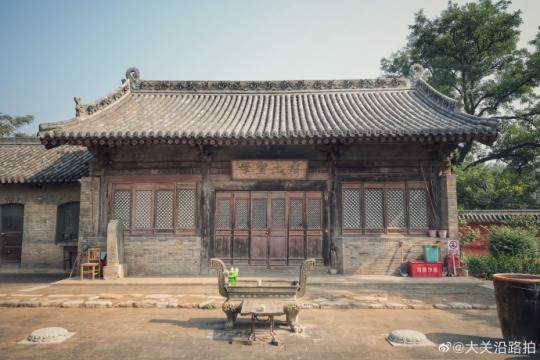

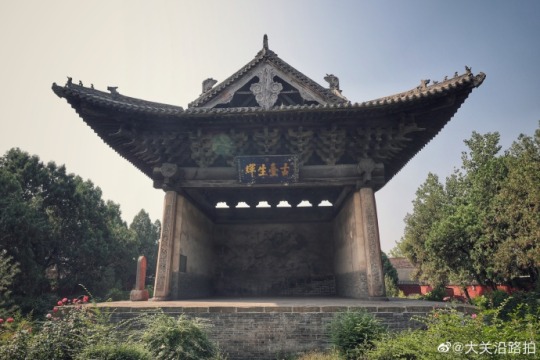
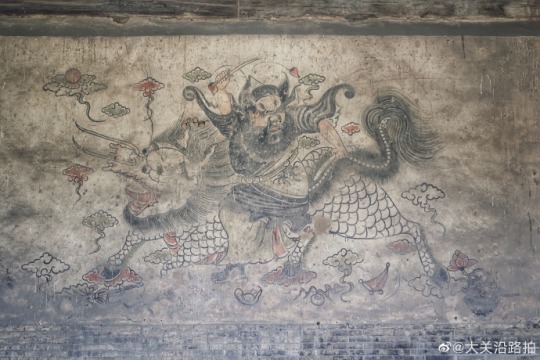
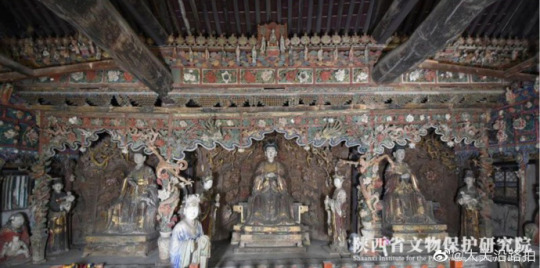
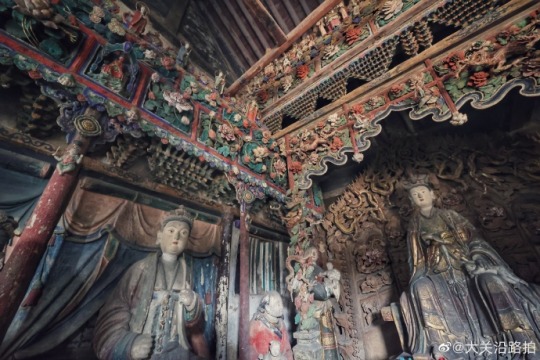

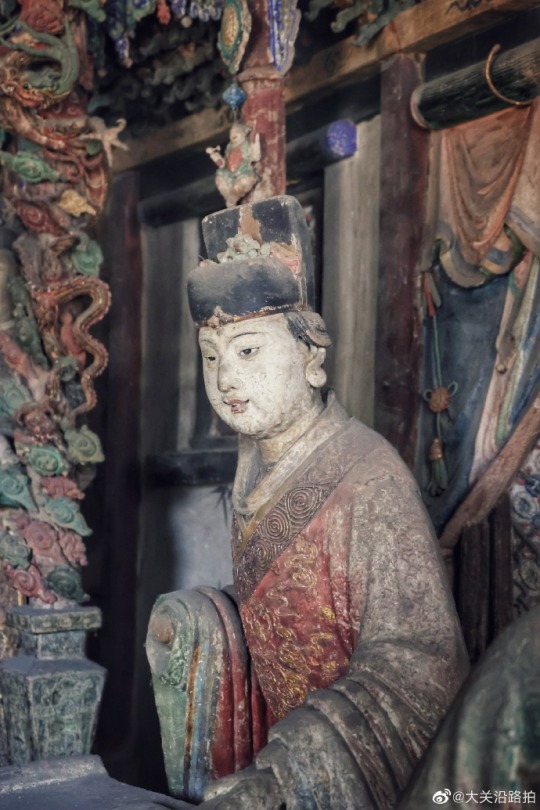

Rural Dongyang Houtu Temple From the Yuan Dynasty
Dongyang Houtu Temple (東羊后土廟), located in Dongyang village, Linfen (臨汾市), Shanxi. Built in the Yuan dynasty, in the fifth year of Zhizheng (至正) (1345). The remaining murals and architecture date from the Yuan dynasty, the altar figurines are from the Ming era.
The temple was erected to worship Houtu (后土神), the Queen of the Earth, ancient goddess of all lands and mountains.
It is curious that the sources of the Spring and Autumn period refer to Houtu as a male deity. Being incorporated into Taoism, Houtu retained his gender from the very beginning, worshipped as one of the Four Heavenly Ministers (四神).
However, he later fell victim to the widespread belief that the Earth represents the Yin principle, and therefore has feminine characteristics. This is how the image of the Lady Mother Earth (地母娘娘) from the late Taoism arose.
Photo: ©大关沿路拍
#ancient china#chinese culture#taoism#chinese art#chinese mythology#ming dynasty#chinese architecture#ming#yuan dynasty#wooden architecture#wooden buildings#chinese customs#taoist#chinese folk religion#Taoist temple#daoism#daoist#chinese temple#religious art#temple architecture#taoist deities#goddess#goddess worship#mother goddess#chinese folklore#后土 四神
173 notes
·
View notes
Note
sorry for being super late to the zhuge liang time-loop party but image we're several iterations in and our boy kongming is sitting in his little mountain hut waiting for liu bei to show up like he always does but this time sun zhou yu turns up instead
oh ho this is a hilarious concept! this is the enemies to enemies timeline we all need. i think it would make more sense for lu su and zhou yu to turn up, because of the simple reason that sun quan is a duke at this point and can't leave the palace for such an extended period of time vs liu bei the one-horse warlord.
ok, the timeline needs to be super fucked up at this stage in order to bring these two togather, because in the alpha timeline even though kongming was fairly well known as a genius hermit, he hasn't done anything so extraordinary at this stage that it warrents a personal visit from the two most powerful people in the southland.
i think we can do this by making him kinda new to the whole timeloop thing, and he accidentally/on purpose reveals some future events in order to get liu bei to find him faster, and it ends up backfiring.
picture this: kongming is sitting in his thatched hut, tears in his eyes, heart all a-flutter, waiting for his beloved leige lord to turn up, and the servant is like "master, there's three important men at the door" (idk who the third guy should be but it's a nice round number. maybe huang gai?) kongming: !!!! "ok, I will play some music to set the mood. i was rude last time by falling asleep and i want to make a good impression."
not even 3 bars in and a VERY familiar voice calls out "you're flat."
kongming is so fucking outraged that for a second he forgets to be surprised because that was ONE HALF-STEP DOWN, ASSHOLE!!!! YOU trying getting reincarnated and deincarnated several times over and then meet your soulmate (he called liu bei that irl, look it up) and see how steady your hands are, asshole!!! god, this is just like wei wuxian from my danmeis...
then it dawns on him that none of the peach garden trio have musical literacy. he runs outside, takes one look at the three men in his courtyard and is like "well, this timeline is a wash. aight im gonna go out back and bash my head in. on second thought, i should do it here and freak zhou yu out. suicidal existential despair is no excuse not to troll zhou yu."
but the afformentioned takes this opportunity to stroll into kongming's bedroom, and starts tuning his qin (not a euphamism) without permission. kong ming says passive-agressively, "i see you're quite adept at tightening another man's strings" (not a euphamism), zhou yu replies "a neglected instrument is like a neglected soul" (not a euphamism), "are you offering to duet?" says kongming through gritted teeth to which zhou yu replies "oh don't worry, i can see you're out of practise so i'll be gentle and take it slow," (not a--) and it's at this point lu su grabs huang gai by the elbow and goes "wow, what a nice bamboo grove! the two of us are going for a walk! a nice LONG walk FAR AWAY in the BAMBOO GROVE for THIRTY TO FORTY MINUTES! see you in THIRTY TO FORTY MINUTES!"
huang gai: i literally spent 30 years in the army you don't need all these euphamisms.
lu su: LALALALA I CAN'T HEAR YOU OVER THE SCENIC RUSTLING OF THE BAMBOO!
*insert that scene from Flirting Scholar where zhou yu and kongming start fighting, they roll under a table, there is a brief skirmish, and they come out with their clothes swaped. they are playing doubles on a single qin the entire time.*
36 notes
·
View notes
Text
[Cdrama Hanfu]𝗖𝗵𝗶𝗻𝗲𝘀𝗲 𝗙𝗶𝘃𝗲 𝗗𝘆𝗻𝗮𝘀𝘁𝗶𝗲𝘀-𝗦𝗼𝗻𝗴 𝗗𝘆𝗻𝗮𝘀𝘁𝘆 (𝟵𝟬𝟳–𝟭𝟮𝟳𝟵𝗔𝗗) 𝗛𝗲𝗮𝗱𝘄𝗲𝗮𝗿 & 𝗛𝗮𝗻𝗳𝘂 𝗶𝗻 𝗖𝗱𝗿𝗮𝗺𝗮【墨雨云间/𝗧𝗵𝗲 𝗗𝗼𝘂𝗯𝗹𝗲】







【Historical Reference Artifacts】
1.China Portrait of Qian Duo (10 March 852– 6 May 932), King Taizu of Wuyue (吳越太祖)<Ming Dynasty replica>

2.China Five Dynasties and Ten Kingdoms period: <White marble relief sculpture of Musician> Unearthed from the tomb of Wang Chuzhi, the governor of Yiwu Army during the Five Dynasties period


3.Chinese Five Dynasties Period and Ten Kingdoms Murals: Tomb of Feng Hui冯晖墓

【History about Chinese Traditional Headwear: Futou】
Futou (simplified Chinese: 幞头; traditional Chinese: 襆頭/幞頭; also pronounced and written as putou), also known as fu (幞) and toujin (頭巾),[1] was one of the most important forms of Chinese headwear in ancient China with a history of more than one thousand years. The futou first appeared in Northern Zhou under the reign of Emperor Wu where it became prevalent. It was also commonly worn in the Tang and Song dynasties. The futou was typically worn by government officials.The futou was originally turban-like headwear which was tied at the back of its wearer's head, with the two corners going to opposite directions and acting as decorations. From the Sui to the Ming dynasties, the futou evolved and was developed based on the fujin.The futou eventually came to assume a variety of shapes and styles.The shape of the futou worn by the government officials in the Song and Ming dynasties, the latter known as the wushamao (烏紗帽), was based on the futou of the Tang dynasty.
The Chinese futou was also introduced in both Korea Unified Silla and continued to be worn by government officials until the late Korea Joseon: 25 The futou with a jinzi (lining) was also introduced back in the Sogdian areas in Central Asia spreading to the Western regions through the Xinjiang region. The futou with jinzi was also introduced in Japan during the Japan Nara period through Prince Shōtaku.
Sui, Tang dynasty, and Five dynasties and ten kingdoms period
Prior to the Song dynasty, the futou was mostly made of black muslin. In the early Tang, the futou was a sijiaoruanjin (四腳軟巾; 'Four-feet soft scarf'),where all four ribbons were allowed to hang down after being tied. Later on, the early Tang dynasty minister, Ma Zhou, was the first person to use a square kerchief in order to tie a futou and was also the person who added a lining to shape his futou making it more beautiful.The lining which was added to the inside of the futou from the year 614 AD was called jinzi (巾子); the jinzi was used to make the futou look more straight and beautiful in terms of appearance. After being cut into the desired shape, the jinzi was painted black with lacquer and would then be covered by the futou. The jinzi was made with soft and light tung wood and with other materials such as bamboo strips, timbo, miscanthus, silk, and leather. It was also possible to line the futou with a mount-shaped item made out of paulownia (Chinese: 桐木为冠; pinyin: Tóngmù wéi guān; lit. 'paulownia crown') in the front. The step-by-step process to wear the futou with jinzi was to tie the hair up in a topknot, followed by covering the topknot with the jinzi as hard lining, then wrapping the head and the jinzi with a black, square-shaped piece of cloth, and finally tying the cloth in the desired style. The futou with jinzi then became the standard form of futou in the early Tang dynasty. A form of futou with jinzi was a kerchief with two corners attached with two ribbons in opposite directions of each other; the ribbons would then be tied at the back of the wearer's head, allowing the two back ribbons to hang down freely as a form of decoration.With time, the futou with jinzi was further developed, and a ribbon was attached to each corner of the turban to make it more decorative; two ribbons were tied on the top of the head while the back ribbons were tied and were allowed to hang down freely. The futou with jinzi could also have all four ribbons tied at the back of the head and allowed to hang down freely. The yingwangboyang (Chinese: 英王踣样), a futou with a big and forward top jinzi, was created by Emperor Zhongzong and became prevalent during his reign when he awarded this type of futou to his officials. During the reign of Emperor Xuanzong, the neiyang (Chinese: 内样), a futou with a small and round top jinzi became popular around the year 726 AD. Moreover, by adding wire or silk strings inside the added ribbons, the futou could take different shapes and styles depending on its wearer's liking. However, in the Tang dynasty, only the Emperors could use these hard ribbons; these hard ribbons would be bent upward.The Tang dynasties emperor wore a futou with two upturned tails until the Five dynasties period.The Tang dynasty emperors also wore the zhijiaofutou (Chinese: 直腳幞头; pinyin: zhíjiǎofútóu; lit. 'straight-feet futou').
For more the history of futou's evolution, please refer to:
The evolution of futou in China
—————-
Photo:Chinese Actor 曾柯琅/Zeng Kelang
CDrama name:【墨雨云间/𝗧𝗵𝗲 𝗗𝗼𝘂𝗯𝗹𝗲】
🔗Weibo:https://weibo.com/u/7823001376
—————-
#chinese hanfu#Cdrama#墨雨云间/𝗧𝗵𝗲 𝗗𝗼𝘂𝗯𝗹𝗲#the double#hanfu#hanfu accessories#Five Dynasties and Ten Kingdoms period (Chinese: 五代十國)#hanfu_challenge#chinese traditional clothing#china#chinese#漢服#汉服#中華風#futou#Chinese Traditional Headwear#幞头#襆頭/幞頭#墨雨云间#chinese drama#曾柯琅/Zeng Kelang
141 notes
·
View notes
Note
This is gonna seem so random but I think we’re all looking for a little escapism today. I see you’ve read Golden Stage! As someone very new to danmei…any recs for similar stories? I guess I mostly mean danmei but with a solid plot outside of the romance. Sadly I’ve already read all MXTX’s stuff.
*waves* HELLO ANON. YES. I am happy to discuss this topic or literally ANYTHING that isn't *gestures vaguely*.
I've read a fair amount of danmei, and I really liked Golden Stage. What I personally loved about Golden Stage was the politicking, which is something I enjoy tons in most books, and that plus the romance really made the book for me. If you're similar - which it sounds like you are! - here are some titles I've read that spring to mind:
Thousand Autumns by Meng Xi Shi (officially licensed, all volumes out): a wuxia novel about an evil sect leader, Yan Wushi, and the fallen leader of a noble, upright daoist sect, Shen Qiao. The politicking is complex and excellent, and it's most definitely romance-lite. Yan Wushi is a horribly wonderful little gremlin of a man, and Shen Qiao is in my top three fave danmei characters with Chu Wanning and Xie Lian, for an idea of the kind of person he is. Highly recommend.
The Fourteenth Year of Chenghua by Meng Xi Shi (unlicensed; I read the Chichi translation, tho there are some issues with it). Intensely political historical fiction about a low-level but capable administrator during the Ming Dynasty, facing up against the corrupt court of the Emperor and the Emperor's favorite concubine, with the help of a morally upright military officer. It's also romance-lite. Heavy politics/romance-lite is kinda Meng Xi Shi's...thing. The show "The Sleuth of Ming Dynasty is loosely based on this book.
Those Years in Quest of Honor Mine by Man Man He Qi Duo (unlicensed; the fantranslation has unfortunately been deleted, though at least some of it is still on the Wayback machine): a historical-esque (but not set in a specific time period) story about a disgraced former top-exam-scorer who returns to the capital out of necessity to help his charges, and his encounters with his former...crush? ...captor? ...it's complicated... who is now the most feared right-arm of the Emperor. I'd say, of all the titles on this list, this is the one most similar to Golden Stage in terms of the balance between the politics and the romance.
The Imperial Uncle by Da Feng Gua Guo (officially licensed, only one volume long): the uncle of the Emperor has a reputation for scheming that he, himself, thinks is entirely unwarranted. This book is first person, and Prince Huai is a delightfully unreliable narrator. The romance includes some misdirection (I'd consider who he ends up with to be a spoiler) but I really enjoyed this historical-esque political drama.
So...those are the ones that spring to mind from what I've personally read. :D Others may be able to toss some other recs into a reblog or the comments. I hope you find a book you love, anon!
ETA ACK I FORGOT ONE I WANTED TO INCLUDE!
Copper Coins by Mu Su Li (recently licensed by 7s! will start coming out late next year): wuxia historical/fantasy China setting, about a celestial dragon who was gravely injured and is now trying to get healthy again and also figure out who hurt him, and the stolid monk who very begrudgingly starts helping him. This one is less political but has a similar mystery vibe, and the main ship are a lot of fun; their dynamic is similar to Wangxian.
24 notes
·
View notes
Text
April 20, Beijing, China, National Museum of China/中国国家博物馆 (Part 3 – Chinese Historical Fashion Exhibition):
Another cool exhibition that I visited while at the museum, showcasing popular fashion from different dynasties, historical artifacts, and some other relevant artifacts that gave a glimpse into the fashion of different dynasties. What's even cooler is that you can visit this exhibition virtually! (the site is in Chinese but I highly recommend it to everyone, there's so much more to the exhibition than the pictures I post here) Note that this exhibition does not only include historical hanfu, but also historical fashion of the 少数民族 that ruled some of the dynasties. This post will be pre-Ming fashion, and next post will be Ming and Qing era fashion. The reason is because Ming and Qing dynasties are the two most recent dynasties, so there are a lot of surviving artifacts from these two dynasties, which means there are 30+ pictures total and I couldn't fit them all into a single post.
First is a recreation of Han-era (202 BC - 220 AD) hanfu. The woman on the left is wearing a one-piece robe called a qujushenyi/曲裾深衣. The man on the right is wearing the outfit characteristic of Eastern Han dynasty (25 - 220 AD) civil officials, a combo of jinxianguan/进贤冠 hat and zaochaofu/皂朝服 clothing (皂 here means the color black, as in the word "青红皂白", or "blue and red, black and white"):
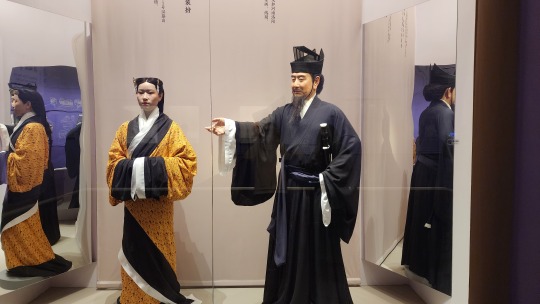
Left: model of a Han-era magpie tail cap/queweiguan/鹊尾冠 (you can see the influence of these Han-era men’s hats on the outfits of male characters in modern xianxia art). Right: recreation of a Han-era bian/弁 hat (the headscarf-like piece tied beneath the chin):
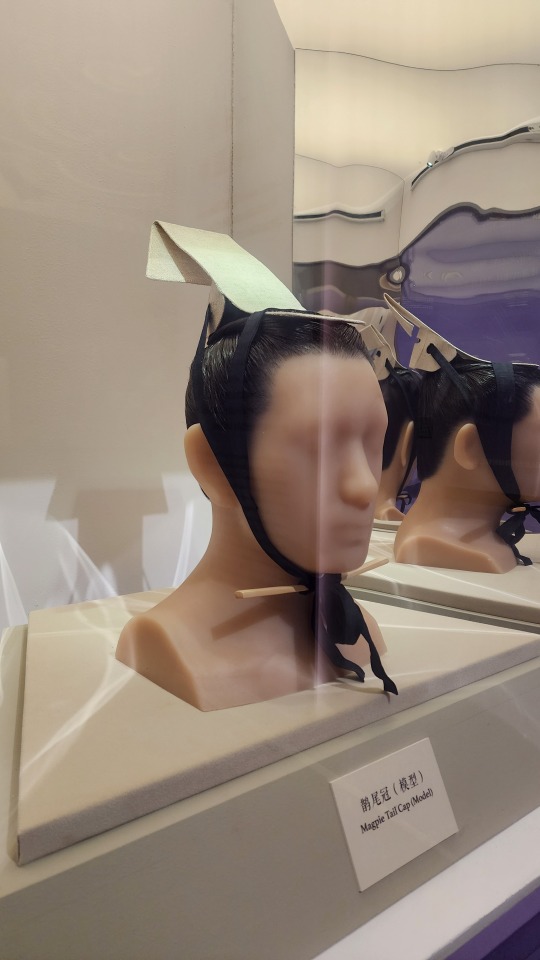

Line drawings of different hats worn by different types of officials based on artifacts and murals. The center and left sections are different hats of military officials (wuguan/武官 in Chinese), and the right section is different hat styles of civil officials (wenguan/文官 in Chinese).
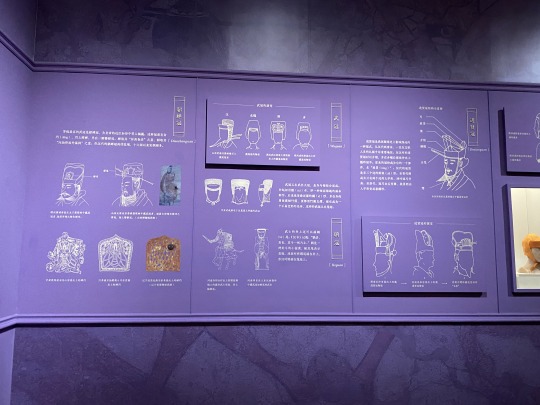
Jumping back, this is a Warring States period (476 - 221 BC) iron daigou/带钩 inlaid with gold and jade and decorated with dragons. Daigou are basically belt buckles where the flat end is attached to one end of the belt, and the hook will hook into slits in the other end of the belt, so this is an extra fancy belt buckle:

On to Tang-era (618 - 907 AD) hanfu. From the left to right these are: the regular outfit of early Tang dynasty officials (color varies by rank, red is worn by fourth and fifth rank officials), the outfit of a female servant in early to mid Tang era, the ceremonial outfit of a Tang dynasty emperor, and the outfit of noblewomen in late Tang to Five Dynasties era (907 - 960 AD):
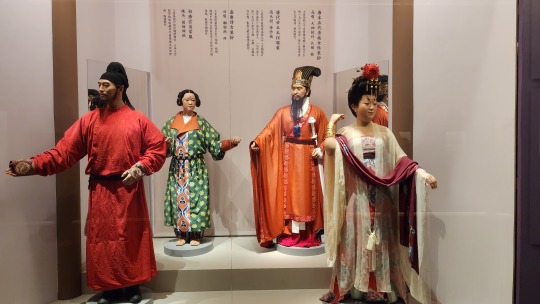
Song-era hanfu (front two) and Yuan-era Mongolian fashion (back two). Front left is the formal attire of Southern Song dynasty (1127 - 1279) civil officials (color varies by rank, red is worn by fourth and fifth rank officials), and front right is the regular outfit of women in Southern Song dynasty. Back left is the formal attire of Mongolian noblewomen in Yuan dynasty (1271 - 1368), and back right is the regular outfit of Mongolian men in Yuan dynasty.
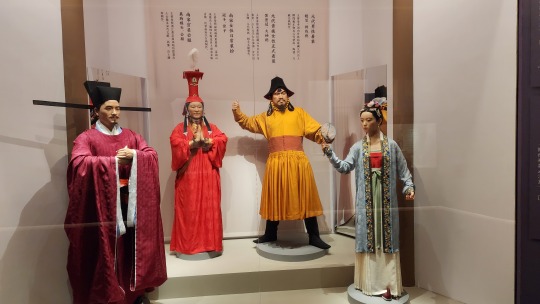
Replicas of painted clay sculptures of women from Northern Song dynasty (960 - 1127), the original sculptures are in Hall of the Holy Mother/圣母殿 of Jinci Temple/晋祠 in Shanxi province:
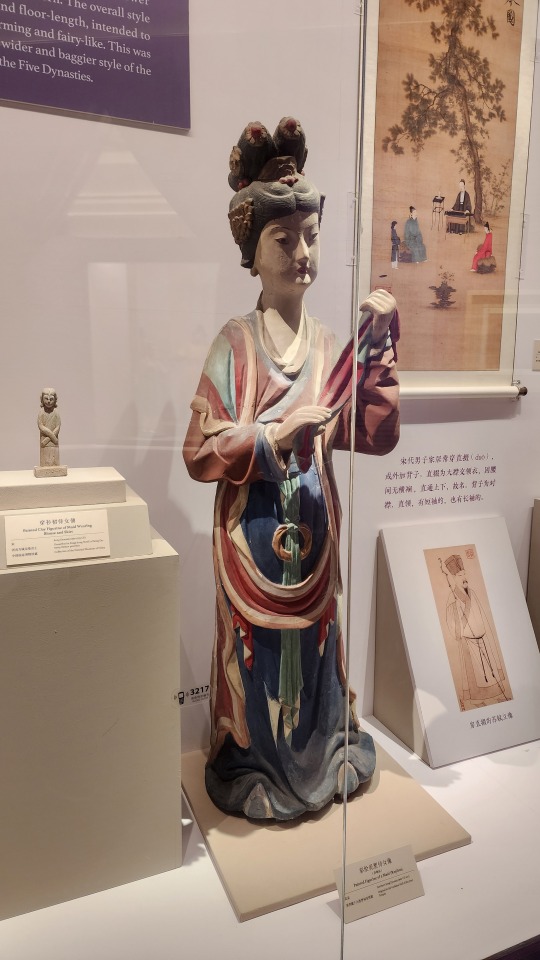

By the way, in the case of Song dynasty, the descriptor "northern" and "southern" basically indicate time periods within Song dynasty (you can refer to the beginning of this post where I explain this in more detail).
And line drawing diagrams of different styles of futou/幞头 hats in Song dynasty based on paintings, murals, and other artifacts:
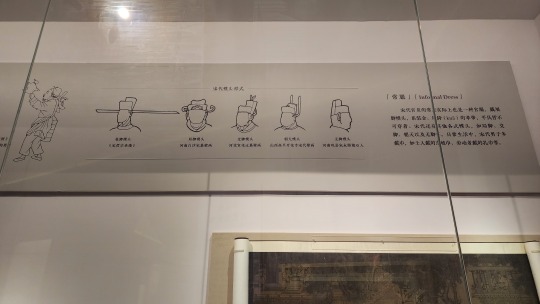
#2024 china#beijing#china#national museum of china#historical fashion#historical clothing#chinese historical fashion#hanfu#mongolian historical fashion#fashion history#chinese history#chinese culture#history#culture
146 notes
·
View notes
Text
Legendary creatures: Kitsune, Kumiho, hồ ly tinh, and huli jing
Fox spirits such as kitsune (狐, きつね) of Japan, kumiho (Hangul 구미호 or Hanja 九尾狐) of Korea, hồ ly tinh (狐狸精) of Vietnam, or huli jing (狐狸精) of China are shape-shifting fox spirits, usually having nine tails. They are typically tricksters that can be either benevolent or malevolent.

By Unknown painter from late 4th to mid 5th century A.D., unknown photographer - http://www.sohu.com/a/193975015_556515, Public Domain, https://commons.wikimedia.org/w/index.php?curid=73024755
The oldest version of the nine-tailed fox spirits was from China. The first story that has the juli jing was the Shanhaijin (山海经 Classic of Mountains and Seas) which was compiled sometime in the fourth century BCE, but the currently known form wasn't completed until the early Han dynasty (202 BCE - 9 CE). It contained stories fables of the pre-Qin dynasty (prior to about 700 BCE). It says '靑丘國在其北其人食五穀衣絲帛其狐四足九尾。 The Land of Blue Hills lies to the north where the inhabitants consume the Five Grains, wear silk and worship foxes that have four legs and nine tails.' The nine-tailed fox was seen as a good omen, only appearing in times of peace. However, it also says 'Three hundred li [150km/93.2 miles]farther east is Qingqiu Mountain, where much jade can be found on its south slope and green cinnabar on its north. There is a beast here whose form resembles a fox with nine tails. It makes a sound like a baby and is a man-eater. Whoever eats it will be protected against insect-poison (gu).' During the Han dynasty, the mythology added the ability to shape-shift into humans as they became older, one description of which was by Guo Pu (郭璞, 276-326 CE) 'When a fox is fifty years old, it can transform itself into a woman; when a hundred years old, it becomes a beautiful female, or a spirit medium, or an adult male who has sexual intercourse with women. Such beings are able to know things at more than a thousand miles' distance; they can poison men by sorcery, or possess and bewilder them, so that they lose their memory and knowledge; and when a fox is thousand years old, it ascends to heaven and becomes a celestial fox.'
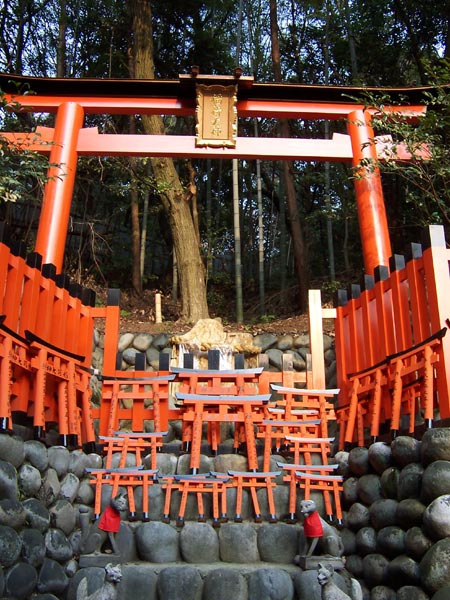
By Chris Gladis (MShades) from Kyoto, Japan - Flickr, CC BY 2.0, https://commons.wikimedia.org/w/index.php?curid=748434
Fox worship arrived in Japan sometime during the Jomon period (14,000-300 BCE) as evidenced by necklaces including canine teeth and jawbones of foxes. Stories from China were brought to Japan by merchants who traded and brought in as kyuubi no kitsune (九尾の狐, nine-tailed fox). In the Nihon Shoki (日本書紀, the Chronicles of Japan), which is the second-oldest book of Japanese history, mentions foxes twice, both times as omens. It records that in 657 a byakko (white fox) in Iwami Province was a good omen. In 659, a fox bit a vine a construction worker and it was seen as an ill omen. There were tales of kitsune turning into kitsune nyoubo (狐女房 fox wife) that are revealed as foxes after pet dogs that were recorded in the Nihon Ryouki (日本霊異記) book of fables during the Heian period (recorded between 787-824).

By Hùng Phong Lê - Hùng Phong Lê, Public Domain, https://commons.wikimedia.org/w/index.php?curid=134883158
The Hồ ly tinh have specific ages that they have to reach to gain their tails. They must practice for a hundred years to have three tails and be considered a 'demon fox', for a thousand years to become a 'ghost fox' with six tails. When it gains nine tails, it's considered a 'celestial fox' and can turn its tails into humans. If the fox loses its tail, it dies. In the Đại Việt sử ký toàn thư (chữ Hán: 大越史記全書, Complete annals of Đại Việt), compiled in 1697, states that Emperor Lê Thái Tổ was saved by a hồ ly tinh when he was hiding in Lam Sơn from the Ming army. He took the time during his hiding to bury a girl in a white dress and that a white fox distracted the army when he was almost caught.
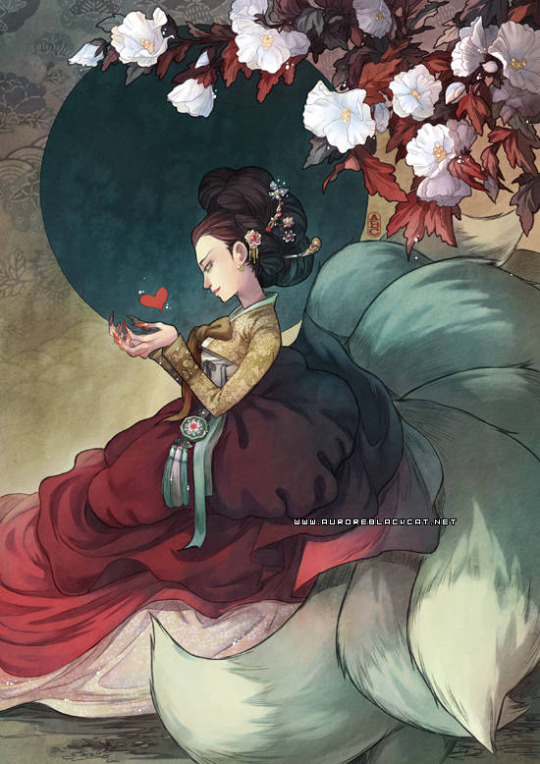
source: https://www.deviantart.com/auroreblackcat/art/Gumiho-283762936
The kumiho are able to become beautiful women who seduce men to eat their liver or heart. The Chinese story entered into Korea during the Three Kingdoms period (삼국시대, from about 494-562) and state that foxes become kumiho with great age and become stronger with that age, too. The kumiho were largely viewed neutrally, though self-centered in their need for human organs and souls. It wasn't until later that they were viewed as evil, bloodthirsty fox-human hybrids that might turn into humans if they can avoid eating human flesh for a thousand years. Something unique to the kumiho is that they develop and pass along 'yeowoo geseul' (여우구슬, 'fox marbles' that they give to and then take back from humans by an action that looks like kissing. It can only remain in the human part of the chain for a year before it can kill them completely. When it's returned to the fox part of the chain, the human has no memory of the yeowoo guseul or the kumino.
#kitsune#kumiho#huli jing#hồ ly tinh#nine tailed fox#spirit foxes#japanese folklore#chinese folklore#vietnamese folklore#korean folklore#legendary creature
25 notes
·
View notes
Text
my stand in ep 6 thoughts, feelings, etc.
lately i don't really have much to say about the show, i don't know that there is much to say on a deeper level because right now things are spelled out pretty clearly as we enter a transitional period of the story.
i did have a thought while watching yesterday's episode that the overarching story formula felt familiar, and then i realized from where. the complicated entanglement between joe, ming, and sol reminds me a lot of a popular iteration of the greek myth of hyacinthus, zephyrus, and apollo.
in this myth apollo is in love with hyacinthus and the two are close, however, zephyrus also harbors a love for hyacinthus. one day, while apollo and hyacinthus are playing with a discus zephyrus' jealousy gets the best of him - i've seen two iterations; one where he decides 'if i can't have hyacinthus no one can' and intentionally blows the discus to strike him, and a second iteration where he blows the discus off track intending to strike apollo but it instead strikes the mortal hyacinthus - either way, the outcome is the same with apollo cradling a dying mortal hyacinthus, weeping over his body, and eventually turning hyacinthus' blood into a flower.
it's not 1:1 direct translation/formula but i definitely think there are a lot of connections that can be made between the two stories and i just think that's neat.
that's all i really have for this week, i'm really swamped with my irl job and i'm very eepy, but i hope you're all enjoying the show as much as i am!
#oat meta#my stand in#my stand in the series#clairedaring#usersasa#this even moreso applies to The Sign tho
33 notes
·
View notes